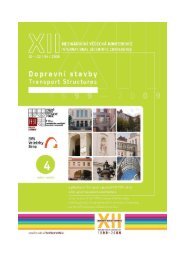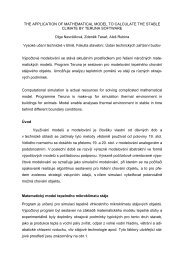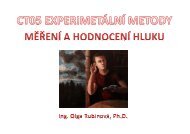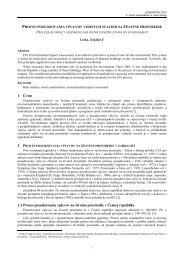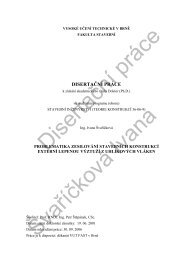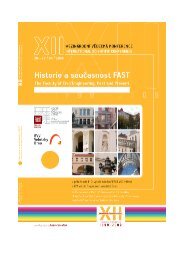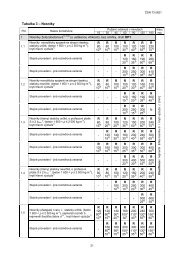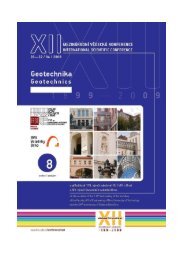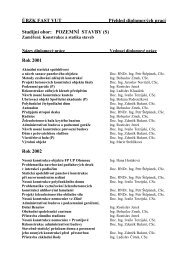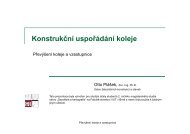Statistical nonlinear analysis - size effect of concrete beams
Statistical nonlinear analysis - size effect of concrete beams
Statistical nonlinear analysis - size effect of concrete beams
Create successful ePaper yourself
Turn your PDF publications into a flip-book with our unique Google optimized e-Paper software.
<strong>Statistical</strong> <strong>nonlinear</strong> <strong>analysis</strong> - <strong>size</strong> <strong>effect</strong> <strong>of</strong> <strong>concrete</strong> <strong>beams</strong>D. Novák & M. VořechovskýInstitute <strong>of</strong> Structural Mechanics, Faculty <strong>of</strong> Civil Engineering, Brno University <strong>of</strong> Technology, Brno,Czech RepublicR. Pukl & V. ČervenkaČervenka Consulting, Praha, Czech RepublicABSTRACT: This paper presents some results on <strong>size</strong> <strong>effect</strong> <strong>of</strong> <strong>concrete</strong> <strong>beams</strong> using statistical <strong>nonlinear</strong>fracture mechanics <strong>analysis</strong>. Computer simulation <strong>of</strong> <strong>concrete</strong> failure is represented by the programSBETA/ATENA. The fracture <strong>of</strong> <strong>concrete</strong> is modeled by the crack band theory based on fracture energyrelateds<strong>of</strong>tening. <strong>Statistical</strong> variability <strong>of</strong> material parameters is introduced in a simple form <strong>of</strong> small-sampleMonte Carlo simulation Latin hypercube sampling. The approach is demonstrated on bending failure <strong>of</strong> plain<strong>concrete</strong> <strong>beams</strong>. Numerical examples are focused on comparison <strong>of</strong> both deterministic and probabilistic simulationresults with experimental data on modulus <strong>of</strong> rupture.1 INTRODUCTIONThe history <strong>of</strong> description <strong>of</strong> phenomenon called<strong>size</strong> <strong>effect</strong> can be seen as a history <strong>of</strong> two fundamentallydifferent approaches - deterministic and statisticalexplanations. First explanation was definitelystatistical - it dates back to the pioneering work <strong>of</strong>Weibull (1939) and many others, mainly mathematicians.Phenomenon that larger specimens will usuallyfracture under relatively smaller applied loadwas that time associated with the statistical theory <strong>of</strong>extreme values. Then most researchers focused onthe energetic basis <strong>of</strong> <strong>size</strong> <strong>effect</strong> and the mainachievements were purely deterministic, leading to“mean <strong>size</strong> <strong>effect</strong> curves”. Let us mention e.g. thebook <strong>of</strong> Bažant & Planas (1998) as an extensivesource <strong>of</strong> information. Uncertainties involved in<strong>concrete</strong> fracture were considered by some researchersusing different theories, from early works e.g.Shinozuka (1972), Mihashi & Izumi (1977), Mazars(1982). Recently, there are attempts to combine lastdecade´s achievements <strong>of</strong> both fracture mechanicsand reliability engineering e.g. Carmeliet (1994),Carmeliet & Hens (1994), Gutiérez & de Borst(1999) and others.Recent studies <strong>of</strong> Bažant & Novák (2000a) onmodulus <strong>of</strong> rupture <strong>of</strong> plain <strong>concrete</strong> <strong>beams</strong> showedthe applicability <strong>of</strong> the probabilistic nonlocalWeibull theory to capture both deterministic and statistical<strong>size</strong> <strong>effect</strong>s. Those results stimulated the development<strong>of</strong> statistical-energetic formula by Bažant& Novák (2000b). Extensive test data on themodulus <strong>of</strong> rupture were used in those papers in orderto verify the theory. The authors showed that forsmall <strong>size</strong>s deterministic <strong>size</strong> <strong>effect</strong> dominates, butfor very large <strong>size</strong>s the influence <strong>of</strong> statistical variability<strong>of</strong> <strong>concrete</strong> strength, leading to Weibull typestatistical <strong>size</strong> <strong>effect</strong>, is decisive.The aim <strong>of</strong> this paper is to present some results <strong>of</strong>the <strong>size</strong> <strong>effect</strong> on modulus <strong>of</strong> rupture obtained bycomputer simulation <strong>of</strong> a beam failure using the programSBETA/ATENA. SBETA is a well-knowns<strong>of</strong>tware for <strong>nonlinear</strong> finite element simulation <strong>of</strong><strong>concrete</strong> and reinforced <strong>concrete</strong> structures. It employs<strong>nonlinear</strong> fracture mechanics and energy basedconcept <strong>of</strong> <strong>concrete</strong> fracture (Margoldová et al.1998, Červenka & Pukl 1999, Červenka 2000). Recentlyintroduced s<strong>of</strong>tware ATENA is an extension<strong>of</strong> SBETA. ATENA is conceptually object-orientedand based on a MS-Windows environment (Červenka& Pukl 2000). It includes all material modelsdeveloped and verified in SBETA. In addition, awide range <strong>of</strong> extensions in the ATENA analyticalcore is available. The user-friendly graphical environment<strong>of</strong>fers excellent support to the user duringall stages <strong>of</strong> the <strong>nonlinear</strong> <strong>analysis</strong>. SBETA/ATENAs<strong>of</strong>tware was used for the deterministic <strong>nonlinear</strong><strong>analysis</strong> <strong>of</strong> <strong>concrete</strong> <strong>beams</strong> <strong>of</strong> different <strong>size</strong>s presentedin this paper.The paper shows the possibility <strong>of</strong> simple “randomization”<strong>of</strong> <strong>nonlinear</strong> <strong>analysis</strong> <strong>of</strong> <strong>concrete</strong> structures.As the scatter <strong>of</strong> some basic input parameters<strong>of</strong> computational model (tensile strength <strong>of</strong> <strong>concrete</strong>,fracture energy etc.) can be large, it is desirable toconsider them to be random variables. Then applyinga suitable type <strong>of</strong> Monte Carlo simulation technique,random variables can be randomly generatedunder their probability distribution functions. Con-
sequently, the particular problem is repeatedlysolved and statistical characteristics <strong>of</strong> structural responsecan be obtained and assessed. As <strong>nonlinear</strong><strong>analysis</strong> is computationally intensive, a suitabletechnique <strong>of</strong> statistical Monte Carlo simulationshould be utilized. The Latin hypercube samplingtechnique appeared to be a very efficient techniquein this context because it requires rather small number<strong>of</strong> simulations for accurate results (Novák et al.1998).Such an approach will be shown on the modulus<strong>of</strong> rupture <strong>size</strong> <strong>effect</strong> problem. The paper presentsfirst selected deterministic simulation results comparedto ten sets <strong>of</strong> experimental data from eightlaboratories. Nonlinear fracture mechanics as appliedin SBETA/ATENA resulted in a good agreementwith these test data (Vořechovský 2000). Second,using a probabilistic approach also thevariability <strong>of</strong> modulus <strong>of</strong> rupture could be obtainedwith reasonable computational effort.The approach, suggested for implementation intoSBETA/ATENA package, is general and can be appliedfor basic statistical <strong>analysis</strong> <strong>of</strong> computationallyintensive fracture mechanics problems. Advantagesand limitations <strong>of</strong> the approach will also be discussedin the paper.Deterministic <strong>size</strong> <strong>effect</strong> represents a transition fromductile behavior <strong>of</strong> relatively small specimens tobrittle behavior <strong>of</strong> large structures. In the numericalinvestigations, the ductile behavior can be coveredby plasticity, while the brittle behavior correspondsto the linear elastic fracture mechanics (LEFM). Forthe transition <strong>nonlinear</strong> fracture mechanics (NLFM)with s<strong>of</strong>tening based on fracture energy (Bažant &Planas 1998) can be <strong>effect</strong>ively used. NLFM is suitablefor <strong>analysis</strong> <strong>of</strong> quasi-brittle materials with certaintoughness like <strong>concrete</strong>. The plastic and the brittlebehavior can be treated as limit situations. Due tothe energetical basis deterministic <strong>size</strong> <strong>effect</strong> can beobtained efficiently by NLFM.The <strong>nonlinear</strong> <strong>analysis</strong> <strong>of</strong> the <strong>concrete</strong> <strong>beams</strong> presentedin this paper has been performed by computerprogram SBETA/ATENA. Suitability <strong>of</strong> this programfor simulation <strong>of</strong> <strong>size</strong> <strong>effect</strong> behavior <strong>of</strong> <strong>concrete</strong>structures was reported by Pukl et al. (1992)and by Červenka & Pukl (1993). The constitutivemodel used in SBETA/ATENA reflects all the essentialfeatures <strong>of</strong> <strong>concrete</strong> behavior, namely crackingin tension. It is based on <strong>nonlinear</strong> damage andfailure functions in plane stress state (Červenka2000). A smeared crack approach simulates discretecracks occurring in real <strong>concrete</strong> structures by strainlocalisation in a continuous displacement field. Concretefracture is covered by <strong>nonlinear</strong> fracture mechanicsbased on fracture energy (Margoldová et al.1998). Exponential s<strong>of</strong>tening law derived experimentallyby Hordijk (1991) is used. Objectivity <strong>of</strong>the finite element solution is assured by crack bandapproach - the descending branch <strong>of</strong> the stress-strainrelationship is adjusted according to the finite element<strong>size</strong> and mesh orientation.The transition from ductile (small beam) to brittle(large beam) behavior is documented in Figure 1.The shape <strong>of</strong> the fracture process zone obtained inSBETA/ATENA simulations for very small (a) andvery large (b) <strong>beams</strong> using data <strong>of</strong> Sabnis & Mirza(1979) is shown. Corresponding load-deflection diagramsare included.2 NONLINEAR FRACTURE MECHANICS ANDSIZE EFFECTFigure 1. Calculated shapes <strong>of</strong> fracture process zone and loaddeflectiondiagrams (based on data <strong>of</strong> Sabnis & Mirza, 1979)a) small beam (span 0.0381 m),b) large beam (span 4.0 m).3 SMALL-SAMPLE MONTE CARLOAPPROACH: LATIN HYPERCUBESAMPLINGThe classical reliability theory introduced the form<strong>of</strong> a response variable (deflection, stress, ultimatecapacity, crack width etc.) or safety margin (in casethat the function expresses failure condition) as thefunction <strong>of</strong> basic random variablesX = , X ,.., X ,...,X12( X )iX nR = g(1)
where g(.) represents functional relationship betweenelements <strong>of</strong> vector X (computational model).Elements <strong>of</strong> vector X are geometrical and materialparameters, load, environmental factors etc., generallyuncertainties (random variables or randomfields). These quantities can naturally also be statisticallycorrelated.The primary goal <strong>of</strong> the statistical <strong>analysis</strong> is theestimation <strong>of</strong> basic statistical parameters <strong>of</strong> responsevariable R, e.g. mean values and variances. Also ahistogram and an empirical cumulative probabilitydistribution function are always valuable information.It can easily be done by Monte Carlo simulation,by repetitive calculations <strong>of</strong> the computationalmodel g(.). But this simple straightforward approachcan be time consuming or even impossible to applyas it requires thousands <strong>of</strong> simulations – repetitivecalculations <strong>of</strong> <strong>nonlinear</strong> fracture mechanics computationalmodel.A special type <strong>of</strong> numerical probabilistic simulationcalled Latin hypercube sampling (LHS) makesit possible to use only a small number <strong>of</strong> simulations.This technique originally proposed by McKayet al. (1979) appeared to be a useful reliability technique,different possibilities <strong>of</strong> efficient use weresummarized by Novák et al. (1998). All randomvariables are divided into N equivalent intervals (Nis a number <strong>of</strong> simulations). This means that therange <strong>of</strong> the cumulative distribution function F(X i )<strong>of</strong> each random variable X i is divided into N intervals<strong>of</strong> equal probability 1/N, (Fig. 2).Figure 2. Illustration <strong>of</strong> LHS – division <strong>of</strong> cumulative probabilitydistribution function into layers.The centroids <strong>of</strong> these intervals are then used in asimulation process. The representative parameters <strong>of</strong>variables are selected randomly based on randompermutations <strong>of</strong> integers 1, 2, ...,j , ..., N. Every interval<strong>of</strong> each variable is used only once during thesimulation. For details see referenced literature.Some improvements <strong>of</strong> LHS were published recentlyby Huntington & Lyrintzis (1998). A relativelylow number <strong>of</strong> simulations (say a ten to ahundred) for good estimates <strong>of</strong> basic statistical parametersproved to be satisfactory. From this point<strong>of</strong> view this technique is very suitable for complex<strong>nonlinear</strong> finite element calculations likeSBETA/ATENA modeling.The main reasons for selection <strong>of</strong> LHS can besummarized as follows:− EFFICIENCY – good accuracy in statistical characteristics<strong>of</strong> structural response using a smallnumber <strong>of</strong> samples (repetitive simulations <strong>of</strong><strong>nonlinear</strong> computationally intensive fracture mechanicscalculation).− SIMPLICITY – the technique is suitable for implementationinto complex commercial s<strong>of</strong>twarelike SBETA/ATENA as it requires minor modifications<strong>of</strong> program core.− TRANSPARENCY – as it represents an alternative<strong>of</strong> Monte Carlo simulation the method istransparent and understandable also to peoplewho are not experts in reliability engineering;generally the Monte Carlo type approach is closeto engineering thinking.4 PROBABILISTIC MODULE PROPOSED FORIMPLEMENTATION INTO ATENAThe aim <strong>of</strong> ATENA statistical <strong>nonlinear</strong> <strong>analysis</strong> isto obtain the estimation <strong>of</strong> the structural responsestatistics (stresses, deflections, failure load etc.).Procedure can be itemized as follows:− Uncertainties are modeled as random variablesdescribed by theirs probability distribution functions(PDF). The optimal case is if all random parametersare measured and real data exist. Thenstatistical assessment <strong>of</strong> this experimental data(e.g. data on strength <strong>of</strong> <strong>concrete</strong> or loading)should be done resulting in selection the most appropriatePDF (e.g. Gausian, lognormal, Weibull,etc.). The result <strong>of</strong> this step is the set <strong>of</strong> input parametersfor ATENA computational model – randomvariables described by mean value, varianceand other statistical parameters (generally byPDF).− Random input parameters are generated accordingto their PDF using Monte Carlo LHS typesimulation.− Generated realizations <strong>of</strong> random parameters arethen used as inputs for ATENA computationalmodel. The complex <strong>nonlinear</strong> solution is performedand results (response) are saved.− Previous two steps are repeated N-times (N is thenumber <strong>of</strong> simulations used). At the end <strong>of</strong> thewhole simulation process the resulting set <strong>of</strong>structural responses is statistically evaluated. Theresults: Mean value, variance, coefficient <strong>of</strong>skewness, histograms, empirical cumulative
probability density function <strong>of</strong> structural response.The implementation <strong>of</strong> basic probabilistic methodsinto ATENA s<strong>of</strong>tware is now under development.Basically it consists <strong>of</strong> three main parts:1 Data input module– Selection and description <strong>of</strong> random variables(theoretical models)– Raw measured data input for some variables– <strong>Statistical</strong> correlation (correlation matrix)– Definition <strong>of</strong> response parameter or limitstate function for <strong>analysis</strong>2 Simulation module– Monte Carlo simulation– Latin hypercube sampling– Simulation monitoring3 <strong>Statistical</strong> assessment and basic reliability module– Histogram, cumulative probability distributionfunction, statistical characteristics– <strong>Statistical</strong> testing to obtain the most suitablemathematical model <strong>of</strong> probability distributionfor response variable or safety margin– Sensitivity <strong>analysis</strong>– Estimation <strong>of</strong> failure probability, reliabilityindex, percentiles5 NUMERICAL EXAMPLES – COMPARISONWITH EXPERIMENTAL DATA5.1 Deterministic comparison with means <strong>of</strong> testdataTen sets <strong>of</strong> experimental data on modulus <strong>of</strong> rupture(both three-point and four-point bending) from eightlaboratories were used for verification <strong>of</strong> nonlocalWeibull theory by Bažant & Novák (2000a,b). Alldetails on these data can be found in referenced literature,here only basic material parameters used forthe SBETA/ATENA calculation are summarized inTable 1. The results <strong>of</strong> comparison with means <strong>of</strong>experimental data are shown as plots <strong>of</strong> modulus <strong>of</strong>rupture versus characteristic <strong>size</strong> D in Figure 3 (d a ismaximum aggregate <strong>size</strong>). Note, that parameters <strong>of</strong>high importance are fracture energy and tensilestrength <strong>of</strong> <strong>concrete</strong>. In most cases these parameterswere not tested, therefore estimations had to be accepted.This step was based on:− Known values <strong>of</strong> compressive strength and splittingtensile strength;− Empirical formulas suggested by recommendations<strong>of</strong> CEB-FIP (1999);− <strong>Statistical</strong> prediction <strong>of</strong> fracture parameters proposedby Bažant & Becq-Giraudon (in press).In spite <strong>of</strong> this fact a very good agreement withtest data has been achieved in most cases. In Figure3 also the results <strong>of</strong> <strong>nonlinear</strong> fitting <strong>of</strong> statisticalenergeticformula according to Bažant & Novák(2000b) are plotted for comparative purposes.SBETA/ATENA results do not represent a fittingapproach that is why larger deviations from test datacould occur. The best available experimental data(large amount <strong>of</strong> information and tested values <strong>of</strong>material parameters) are data <strong>of</strong> Rocco (1997), Rokugo(1995) and Sabnis & Mirza (1979).SBETA/ATENA calculations for these data sets arein best agreement.Table 1. Basic SBETA/ATENA material parameters used forexperimental __________________________________________________data sets.Author Compressive Direct Modulus Fracturestrength tensile <strong>of</strong> energy__________________________________________________strength elasticity__________________________________________________(MPa) (MPa) (GPa) (N/m)Reagel&Willis 72 4.8 50 50(1931)Wright, 3point 30 2.1 30 25(1952)Wright, 4point 30 2.0 30 25(1952)Nielsen 47.3 2.6 40.60 20(1954)Lindner&Sprague 38.25 3.66 21 70(1956)Walker&Bloem, 1" 45 4 35 40(1957)Walker&Bloem, 2" 32 2.72 35 120(1957)Sabnis&Mirza 36 3.85 30 30(1979)Rokugo 40 3.20 27.5 50(1995)Rocco 39.1 4 29.1 56.3(1997) __________________________________________________5.2 <strong>Statistical</strong> variability <strong>of</strong> <strong>size</strong> <strong>effect</strong> curveThe presented example represents one <strong>of</strong> the first attemptsto consider random variability <strong>of</strong> a materialin SBETA/ATENA s<strong>of</strong>tware in a simple form (level<strong>of</strong> random variables). The best suitable data from thestudy were selected for that purpose – data <strong>of</strong> Rocco(1997). For this set also direct tensile strength andfracture energy have been tested. Experimental datashow some scatter <strong>of</strong> modulus <strong>of</strong> rupture, it is highlyprobable that it is the consequence <strong>of</strong> random variability<strong>of</strong> material properties. <strong>Statistical</strong> <strong>analysis</strong> wasbased on only 8 simulations <strong>of</strong> LHS – eight realizations<strong>of</strong> random coefficient normally distributedwith unit mean value and standard deviations 0.2(thus representing variability 20%). The nominal deterministicvalue <strong>of</strong> direct tensile strength forRocco´s data has been multiplied by these realisations– eight direct tensile strengths were consideredin eight simulations. Then the most important materialparameters <strong>of</strong> the SBETA/ATENA constitutivemodel (compressive strength, modulus <strong>of</strong> elasticity,fracture energy and maximum compressive strain)were obtained from these eight realisations <strong>of</strong> directtensile strength utilising recommended formulas <strong>of</strong>
CEB-FIP (1999). It means that a functional relationshipwas considered among all these parameters(unit cor-relation coefficient) for simplicity and also becauseFigure 3. ModuSBETA/ATENAFigure 3. Modulus <strong>of</strong> rupture vs. <strong>size</strong> – comparison <strong>of</strong>SBETA/ATENA NLFM results with experimental data.
<strong>of</strong> lack reliable information on this matter.The <strong>analysis</strong> resulted in estimation <strong>of</strong> mean andpercentiles <strong>size</strong> <strong>effect</strong> curves (modulus <strong>of</strong> rupture vs.<strong>size</strong> D), as shown in Figure 4. Figure presents mean<strong>size</strong> <strong>effect</strong> curve obtained from SBETA/ATENALHS probabilistic simulation compared to means <strong>of</strong>test data and percentiles. It can be seen that the scatterbandfrom simulation is larger than in case <strong>of</strong>tests, which indicates that our assumption <strong>of</strong> 20%material variability was too rough.The next important feature can be seen from Figure4 (and also from Figure 3): Size <strong>effect</strong> curveshave flat horizontal asymptote, mean value (or valuefrom deterministic calculation) <strong>of</strong> modulus <strong>of</strong> ruptureapproaches the direct tensile strength for verylarge <strong>size</strong>s. As it was shown by Bažant & Novák(2000a, b) the slope <strong>of</strong> this asymptote cannot be zero– a decrease <strong>of</strong> modulus <strong>of</strong> rupture with characteristic<strong>size</strong> continues for very large <strong>size</strong>s following theWeibull type <strong>size</strong> <strong>effect</strong>. We should empha<strong>size</strong> thatthe aim here was not to capture statistical <strong>size</strong> <strong>effect</strong>in the sense <strong>of</strong> Weibull theory <strong>of</strong> weakest link conceptbut to show the influence <strong>of</strong> randomness <strong>of</strong> materialon the modulus <strong>of</strong> rupture in a simple form.And naturally the simple form at the level <strong>of</strong> randomvariables cannot capture the phenomena <strong>of</strong> statistical<strong>size</strong> <strong>effect</strong>. But the presented approach appeared tocapture efficiently the deterministic <strong>size</strong> <strong>effect</strong> andits variability.Figure 4. Modulus <strong>of</strong> rupture vs. <strong>size</strong> <strong>of</strong> beam for data <strong>of</strong>Rocco (1997).As LHS covers the full range <strong>of</strong> probabilities, onecan estimate the cumulative probability distributionfunction for the modulus <strong>of</strong> rupture. This is shownfor two <strong>size</strong>s (minimum and maximum) <strong>of</strong> Rocco´sdata in Figure 5. As expected, the steepness increaseswith increasing <strong>size</strong>, which means that thescatter decreases with <strong>size</strong>. It agrees with experimentalobservations, some results <strong>of</strong> Shinozuka(1972) and detailed numerical verification by Bažant& Novák (2000a).Figure 5. Cumulative probability distribution function <strong>of</strong>modulus <strong>of</strong> rupture for extreme <strong>size</strong>s <strong>of</strong> Rocco’s data obtainedby ATENA statistical calculations.5.3 Size <strong>effect</strong> due to bending span <strong>of</strong> <strong>beams</strong> infour-point bendingKoide et al. (1998) tested 279 plain <strong>concrete</strong> <strong>beams</strong>in four-point bending, aimed at determining the influence<strong>of</strong> the beam length L on the flexural strength<strong>of</strong> <strong>beams</strong>. These excellent data allow for a comparison<strong>of</strong> the cumulative probability distribution function(CPDF) <strong>of</strong> the maximum bending moment M maxat failure (Bažant & Novák 2000a). Three <strong>size</strong>s <strong>of</strong><strong>beams</strong> with different bending span (200, 400 and600 mm in series C) are shown in Figure 6. Notethat cross-sections <strong>of</strong> <strong>beams</strong> were kept constant(0.1m x 0.1m).Based on experimental data, there is <strong>size</strong> <strong>effect</strong>due to bending span as is shown in Figure 7, withincreasing bending span the maximum bending momentdecreases. Using ATENA deterministic simulationalmost a flat <strong>size</strong> <strong>effect</strong> curve has been obtained.What is the explanation <strong>of</strong> this result? Themain reason is the difference between the deterministic(energetic) and statistical <strong>size</strong> <strong>effect</strong>. Changingonly bending span and keeping constant <strong>size</strong> D resultedin negligible change <strong>of</strong> energetic deterministic<strong>size</strong> <strong>effect</strong>. The decrease <strong>of</strong> <strong>size</strong> <strong>effect</strong> curve in Figure7 obtained by Koide´s experiment should be attributedto and explained by statistical <strong>size</strong> <strong>effect</strong>. Asbending span increases there is a higher probability<strong>of</strong> defect occurence (small strength) in Weibullsense. Therefore the utilization <strong>of</strong> extreme value statisticsin nonlocal Weibull theory by Bažant &Novák (2000a) appeared to be very efficient to verifyKoide´s results. Both ATENA deterministic calculationand statistical simulation at the level <strong>of</strong> randomvariables cannot capture this phenomenon.
Randomization at the level <strong>of</strong> random fields (stochasticfinite element method) should therefore bethe next direction <strong>of</strong> research in this context.data is presented: Scatter-band <strong>of</strong> <strong>size</strong> <strong>effect</strong>curve and cumulative probability distributionfunction <strong>of</strong> flexural capacity <strong>of</strong> <strong>concrete</strong> <strong>beams</strong>.4 The results presented here represent outcomes <strong>of</strong>initial steps <strong>of</strong> more complex reliability treatment<strong>of</strong> ATENA s<strong>of</strong>tware which is under development:statistical, sensitivity and reliability (failure probabilitycalculation) analyses, first implemented atthe random variables level and later at the randomfields level (stochastic <strong>nonlinear</strong> finite elementmethod).ACKNOWLEDGMENTSFigure 6. Three <strong>size</strong>s <strong>of</strong> <strong>beams</strong> (bending span 200, 400 and 600mm) tested by Koide's (1998), series C.The results presented in this paper are related to researchtopics supported by grants <strong>of</strong> Grant Agency<strong>of</strong> Czech Republic (GAČR) No. 103/00/0603, No.103/99/0755 and No. 103/00/1563. The financialsupport is greatly appreciated.REFERENCESFigure 7. Comparison <strong>of</strong> means <strong>of</strong> Koide´s data and ATENAsimulations.6 CONCLUSIONS1 Results <strong>of</strong> <strong>size</strong> <strong>effect</strong> calculations on modulus <strong>of</strong>rupture obtained by SBETA/ATENA in a deterministicsense are in a very good agreement withexperimental data. Generally, it supports the ability<strong>of</strong> <strong>nonlinear</strong> fracture mechanics tools implementedinto SBETA/ATENA s<strong>of</strong>tware to capturethis phenomenon correctly.2 The idea <strong>of</strong> “randomization” <strong>of</strong> this s<strong>of</strong>tware hasbeen conceived: It is based on small-sampleMonte Carlo approach Latin hypercube samplingwhich gives accurate estimates <strong>of</strong> statistical characteristics<strong>of</strong> response using only a small number<strong>of</strong> simulations.3 The feasibility <strong>of</strong> statistical approach is shownusing numerical examples on modulus <strong>of</strong> rupture.Comparison with statistics <strong>of</strong> some experimentalBažant, Z.P. & Becq-Giraudon, E. 2000. <strong>Statistical</strong> prediction<strong>of</strong> fracture parameters <strong>of</strong> <strong>concrete</strong>. ACI Mat. J.: (in press).Bažant, Z.P. & Novák, D. 2000a. Probabilistic nonlocal theoryfor quasi-brittle fracture initiation and <strong>size</strong> <strong>effect</strong>. I Theory,and II. Application. Journal <strong>of</strong> Engineering MechanicsASCE, 126 (2): 166-185.Bažant, Z.P. & Novák, D. 2000b. Energetic-statistical <strong>size</strong> <strong>effect</strong>in quasi-brittle failure at crack initiation. ACI MaterialsJournal, 97 (3): 381-382.Bažant, Z.P. & Planas, J. 1998. Fracture and <strong>size</strong> <strong>effect</strong> in <strong>concrete</strong>and other quasi-brittle materials. Boca Raton, Florida,and London: CRC Press.CEB/FIP 1999. Updated model code, FIB, Lousanne, Switzerland– FIB: Manual textbook FIB Bulletin 1, Structural<strong>concrete</strong> textbook on behavior, design and performance,Vol. 1 (Introduction, design process, materials).Carmeliet, J. 1994. On stochastic descriptions for damageevaluation in quasi-brittle materials. DIANA ComputationalMechanics, G.M.A. Kusters and M.A.N. Hendriks (eds.).Carmeliet, J. & Hens, H. 1994. Probabilistic nonlocal damagemodel for continua with random field properties. ASCEJournal <strong>of</strong> Engineering Mechanics, 120 (10): 2013-2027.Červenka, V. 2000. Simulating a response. Concrete EngineeringInternational, 4 (4): 45-49.Červenka, V. & Pukl, R. 1993. SBETA <strong>analysis</strong> <strong>of</strong> <strong>size</strong> <strong>effect</strong>in <strong>concrete</strong> structures. Proc. <strong>of</strong> Int. Workshop on Size Effectin Concrete Structures, Sendai, Japan: 271-281.Červenka, V. & Pukl, R. 1999. SBETA – Computer Programfor Nonlinear Finite Element Analysis <strong>of</strong> Reinforced ConcreteStructures in Plane Stress State. Program documentation.Prague, Czech republic: Červenka Consulting.Červenka, V. & Pukl, R. 2000. ATENA – Computer Programfor Nonlinear Finite Element Analysis <strong>of</strong> Reinforced ConcreteStructures. Program documentation. Prague, Czechrepublic: Červenka Consulting.Gutiérez, M.A. & de Borst, R. 1999. Deterministic and stochastic<strong>analysis</strong> <strong>of</strong> <strong>size</strong> <strong>effect</strong>s and damage evaluation inquasi-brittle materials. Archive <strong>of</strong> Applied Mechanics, 69:655-676.
Hordijk, D.A. 1991. Local approach to fatique <strong>of</strong> <strong>concrete</strong>.Doctor dissertation, Delft University <strong>of</strong> Technology, TheNetherlands, ISBN 90-9004519-8.Huntington, D.E. & Lyrintzis, C.S. 1998. Improvements to andlimitations <strong>of</strong> Latin hypercube sampling. Probabilistic EngineeringMechanics, 13 (4): 245-253.Koide, H., Akita, H. & Tomon, M. 1998. Size <strong>effect</strong> on flexuralresistance due to bending span <strong>of</strong> <strong>concrete</strong> <strong>beams</strong>. InH. Mihashi and K. Rokugo, (eds), Proc., 3 rd Int. Conf.FraMCoS-3 Fracture Mechanics <strong>of</strong> Concrete Structures,held in Gifu, Japan: 2121-2130. Freiburg Germany: AedificatioPublishers.Lindner, C.P. & Sprague, I.C. 1956. Effect <strong>of</strong> depth <strong>of</strong> <strong>beams</strong>upon the modulus <strong>of</strong> rupture <strong>of</strong> plain <strong>concrete</strong>. ASTMProc., 55: 1062-1083.Margoldová, J., Červenka, V. & Pukl, R. 1998. Applied brittle<strong>analysis</strong>. Concrete Engineering International, 8 (2): 65-69.Mazars, J. 1982. Probabilistic aspects <strong>of</strong> mechanical damage in<strong>concrete</strong> structures. In G. C. Sih (ed.), Proc., Conf. onFracture Mech. Technol. Appl. to Mat. Evaluation andStruct. Design, Melbourne, Australia: 657-666.McKay, M. D., Conover, W.J. & Beckman, R.J. 1979. A Comparison<strong>of</strong> Three Methods for Selecting Values <strong>of</strong> InputVariables in the Analysis <strong>of</strong> Output from a Computer Code.Technometrics, Vol. 21: 239-245.Mihashi, H. & Izumi, M. 1977. A stochastic theory for <strong>concrete</strong>fracture. Cement and Concrete Research, PergamonPress Vol. 7: 411-422.Nielsen, K.E.C. 1954. Effects <strong>of</strong> various factors on the flexuralstrength <strong>of</strong> <strong>concrete</strong> test <strong>beams</strong>. Magazine <strong>of</strong> Concrete Research,15: 105-114.Novák, D., Teplý, B. & Keršner, Z. 1998. The role <strong>of</strong> LatinHypercube Sampling method in reliability engineering. InShiraishi N., Shinozuka M., Wen Y.K., (eds). Proceedings.<strong>of</strong> ICOSSAR-97 - 7 th International Conference on StructuralSafety and Reliability, Kyoto, Japan: 403-409. Rotterdam:Balkema.Pukl, R., Eligehausen, R. & Červenka, V. 1992. Computersimulation <strong>of</strong> pullout test <strong>of</strong> headed anchors in a state <strong>of</strong>plane-stress. In W. Gerstle and Z.P. Bažant (eds.), Concretedesign based on fracture mechanics, ACI SP-134, Detroit,Michigan, USA: 79-100.Reagel, F.V. & Willis, G.H. 1931. The <strong>effect</strong> <strong>of</strong> dimensions <strong>of</strong>test specimens on the flexural strength <strong>of</strong> <strong>concrete</strong>. PublicRoads, 12: 37-46.Rocco, C.G. 1997. Private communication by Jaime Planas onUnpublished tests <strong>of</strong> <strong>size</strong> <strong>effect</strong> on modulus <strong>of</strong> rupture <strong>of</strong><strong>concrete</strong> at Technical University, Madrid (pers. com.).Rokugo, K., Uchida, Y., Katoh, H. & Koyanagi, W. 1995.Fracture mechanics approach to evaluation <strong>of</strong> flexurestrength <strong>of</strong> <strong>concrete</strong>. ACI Materials Journal, 92 (5), (Selectedtranslation from Japan Concrete Institute): 561-566.Sabnis, G.M. & Mirza, S.M. 1979. Size <strong>effect</strong>s in model <strong>concrete</strong>s?ASCE Journal <strong>of</strong> Structural Division, 106: 1007-1020.Shinozuka, M. 1972. Probabilistic modeling <strong>of</strong> <strong>concrete</strong> structures.ASCE Journal <strong>of</strong> Engineering Mechanics, Vol. 98,EM6: 1433-1451.Vořechovský, M. 2000. Reliability calculations <strong>of</strong> problems <strong>of</strong><strong>nonlinear</strong> continuum mechanics. MSc thesis, Institute <strong>of</strong>Structural Mechanics, Faculty <strong>of</strong> Civil Engineering, BrnoUniversity <strong>of</strong> Technology, Czech Republic, (in Czech).Walker, S. & Bloem, D.L. 1957. Studies <strong>of</strong> flexural strength <strong>of</strong><strong>concrete</strong>. Part 3: Effect <strong>of</strong> variations in testing procedures.ASTM Proc., 57: 1122-1139.Weibull, W. 1939. The phenomenon <strong>of</strong> rupture in solids.Proc., Royal Swedish Institute <strong>of</strong> Engineering Research(Ingenioersvetenskaps Akad. Handl.) 153, Stockholm: 1-55.Wright, P.J.F. 1952. The <strong>effect</strong> <strong>of</strong> the method <strong>of</strong> test on theflexural strength <strong>of</strong> <strong>concrete</strong>. Magazine <strong>of</strong> Concrete Research,11: 67-76.



